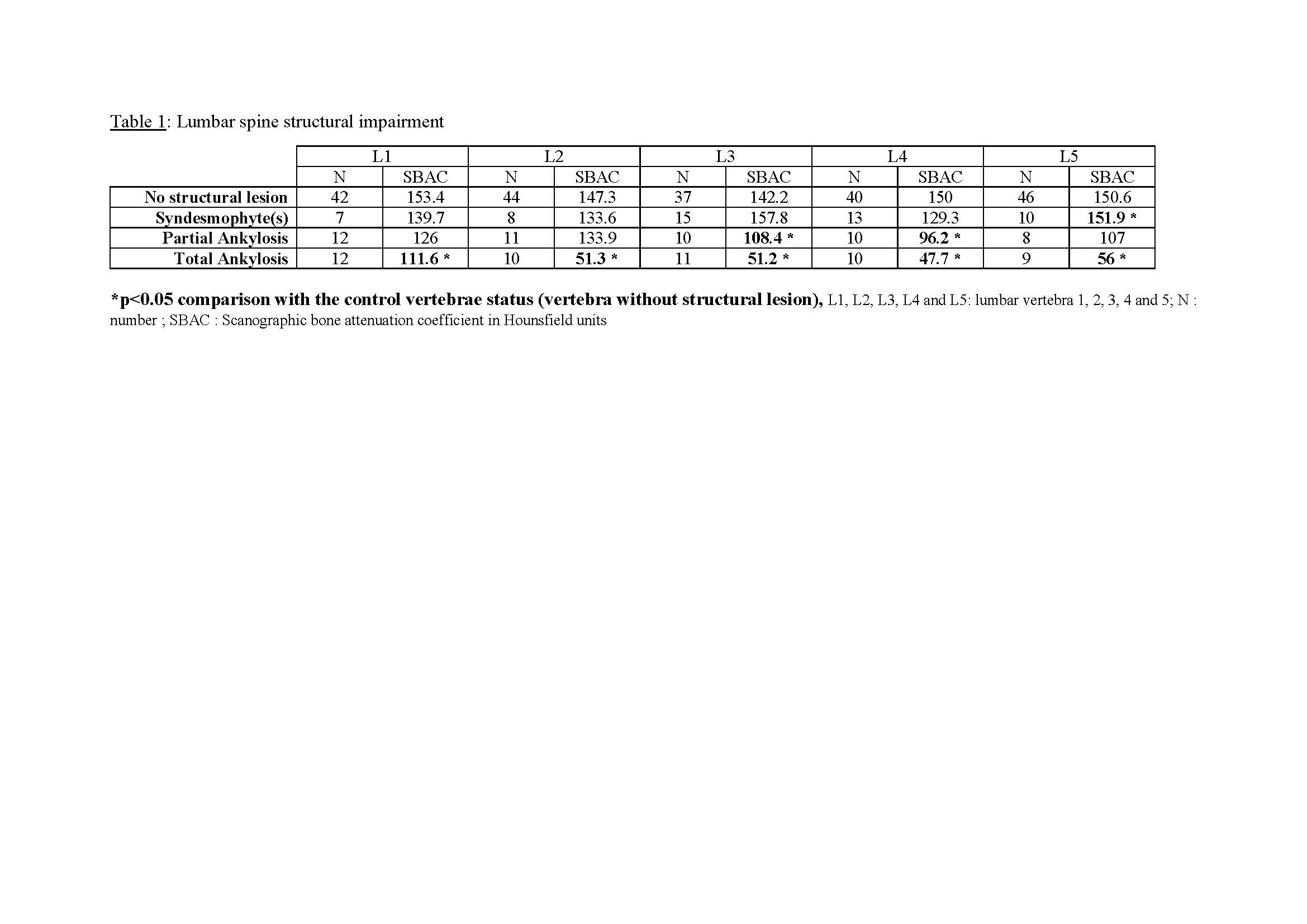Session Information
Date: Tuesday, November 12, 2019
Title: Osteoporosis & Metabolic Bone Disease – Basic & Clinical Science Poster
Session Type: Poster Session (Tuesday)
Session Time: 9:00AM-11:00AM
Background/Purpose: Computed Tomography (CT) is sometimes performed during the follow up of patients with ankylosing spondylitis (AS) to screen comorbidities or complications. Thoracic or thoraco-abdomino-pelvic (TAP) CT have demonstrated their ability to depict vertebral fracture and recently to assess trabecular bone fragility though the scanographic bone attenuation coefficient (SBAC) on lumbar vertebrae (L1 to L5). To your knowledge, no study has assessed the impact of partial or complete vertebra ankylosis on the trabecular bone.
The principal objective was to characterize the SBAC on normal lumbar spine or spine with partial or total ankylosis.
Methods: This monocentric retrospective study included patients with AS followed from 2009 to 2017 at Nancy university hospital, fulfilling New-York criteria for AS and who underwent a thoracic or TAP CT and X-rays (spine, pelvis) within 2 years. Clinical characteristics were collected. Modified stoke ankylosing spondylitis spinal score (mSASSS) was scored by two readers, adjudication for one syndesmophyte discordance. Presence of one syndesmophyte defined mSASSS+ (mSASSS ≥ 2). Moreover, each lumbar vertebra was studied according to its level of ankylosis, 0: no lesion, 1: syndesmophyte(s), 2: partial ankylosis (superior or inferior) and 3: total ankylosis (both inferior and superior). The SBAC was measured in Hounsfield Units (HU) on L1 to L5 vertebrae, and a fracture threshold was defined at ≤145 HU.
Results: On 1503 spondyloarthritits, 73 AS patients were included (mean age: 60.3 (±10.7) years, 8 women (11%)). Sixty patients (82.2%) had a mSASSS ≥ 2, with a mean score of 20.7 (±21.2). Presence of ankylosis of at least one disco-vertebral unit in cervical or lumbar segments of the spine on mSASSS was observed in 37 patients (50.7%) and 6 (8.2%) have total lumbar spine ankylosis. Concerning the lumbar spine, the details of number of vertebrae without structural lesion, with syndesmophyte(s) or with partial and complete ankylosis are presented in table 1. The SBAC for each lumbar vertebra were not significantly different between patients with mSASSS < 2 versus mSASSS ≥ 2 (p = 0.24 to 0.99). However, the SBAC was lower for patients with mSASSS≥ 2 and bone bridge than for patients with mSASSS≥ 2 without bone bridge (p = 0.02 to 0.0001). The risk of SBAC ≤ 145 HU was higher in presence of total ankylosis on at least one lumbar vertebra (HR: 4.95(CI95% :1.104-17.36, p = 0.04 to 0.001)). Partial lumbar ankylosis of L3 and L4 affected also the SBAC with higher risk to have a SBAC ≤145 HU (HR :11.8 (CI95% :1.822-25.67) and 15 (CI95%: 2.54-30.85)) respectively.
Conclusion: Only AS patients with ankylosed vertebra on mSASSS presented lower values of SBAC. We showed that complete ankylosis of any lumbar vertebra and partial ankylosis of L3 and L4 were associated with lower values of SBAC, suggesting deterioration of the trabecular bone structure ankylosed.

ACR Article 2 Abstract Table VF
To cite this abstract in AMA style:
Fauny M, Morizot C, Allado E, VERHOEVEN F, Albuisson E, Pinzano-Watrin A, Chary-Valckenaere I, Loeuille D. What Are the Consequences of Spinal Ankylosis on the Bone Trabecular Fragility Assessed on CT- scan in Patients with Ankylosing Spondylitis? [abstract]. Arthritis Rheumatol. 2019; 71 (suppl 10). https://acrabstracts.org/abstract/what-are-the-consequences-of-spinal-ankylosis-on-the-bone-trabecular-fragility-assessed-on-ct-scan-in-patients-with-ankylosing-spondylitis/. Accessed .« Back to 2019 ACR/ARP Annual Meeting
ACR Meeting Abstracts - https://acrabstracts.org/abstract/what-are-the-consequences-of-spinal-ankylosis-on-the-bone-trabecular-fragility-assessed-on-ct-scan-in-patients-with-ankylosing-spondylitis/
